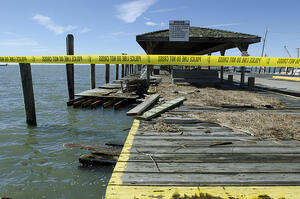While 50 Americans have died as a result of Sandy, the toll across the Caribbean is 70, most of them in the desperately poor country of Haiti.
Haiti
Haiti was not actually directly in the path of the hurricane, but over 50 people were killed there and more are missing. Mudslides destroyed houses and flood tides swept people out to sea. The government in Port-au-Prince estimates that about 200,000 people are homeless. They have been able to provide emergency shelter for 17,000. There are reports of cholera and other water-borne diseases, along with food shortages because crops have been badly damaged.
So why were the people of Haiti so vulnerable? Some 370,000 were still in tents and shanties following the earthquake in 2010 which killed more than 200,000 people. In a region where hurricanes are an annual event, lack of basic shelter guarantees that a storm becomes a disaster. Sandy brought 50 cm of rain in three days, not that long after Hurricane Isaac passed through in August. Families flooded out by Issac have seen their dwellings inundated once again.
Jamaica and Cuba
Sandy also hit Jamaica. Streets were flooded, homes damaged and there were power cuts. At least one death has been reported. However, the emergency services seem to have done a good job in evacuating flood-prone areas and providing shelters for those displaced. Mudslides on the steep hills outside Kingston will have damaged property, with informal settlements especially vulnerable.
Cuba also suffered, as the storm ripped off roofs, felled trees and demolished houses in the east of the island. Again some poor people lost what little they had.
Planning for disasters
Good governance is vital to disaster mitigation. Back in 2005 the Hyogo Framework for Action set out a ten year plan to reduce vulnerability to disasters worldwide. It was adopted by the UN. Building on this the UN Office for Disaster Risk Reduction has developed a 10 point check list for cities to follow.
1. Put in place organization and coordination to understand and reduce disaster risk, based on participation of citizen groups and civil society. Build local alliances. Ensure that all departments understand their role to disaster risk reduction and preparedness.
2. Assign a budget for disaster risk reduction and provide incentives for homeowners, low-income families, communities, businesses and public sector to invest in reducing the risks they face.
3. Maintain up-to-date data on hazards and vulnerabilities, prepare risk assessments and use these as the basis for urban development plans and decisions. Ensure that this information and the plans for your city's resilience are readily available to the public and fully discussed with them.
4. Invest in and maintain critical infrastructure that reduces risk, such as flood drainage, adjusted where needed to cope with climate change.
5. Assess the safety of all schools and health facilities and upgrade these as necessary.
6. Apply and enforce realistic, risk compliant building regulations and land use planning principles. Identify safe land for low-income citizens and develop upgrading of informal settlements, wherever feasible.
7. Ensure education programmes and training on disaster risk reduction are in place in schools and local communities.
8. Protect ecosystems and natural buffers to mitigate floods, storm surges and other hazards to which your city may be vulnerable. Adapt to climate change by building on good risk reduction practices.
9. Install early warning systems and emergency management capacities in your city and hold regular public preparedness drills.
10. After any disaster, ensure that the needs of the survivors are placed at the centre of reconstruction with support for them and their community organizations to design and help implement responses, including rebuilding homes and livelihoods.
Act before it is too late
Ironically the easiest time to persuade governments to take disaster risk reduction actions tends to be when the disaster has happened. In today’s climate of austerity there is little political appeal in investment to mitigate the risk of future environmental disasters that may never happen. This is one reason why climate change has fallen so low in the priorities of European and North American governments since 2009 – though it still remains a matter of intense concern in small island developing states, which are in the “front line” in terms of the impacts of rising sea levels, for example. Maybe Hurricane Sandy can help refocus political thinking in the US so that environmental risks are addressed there – and globally. Meanwhile, in the spirit of “Think globally, act locally” do you know what action your municipality is taking to reduce exposure to environmental hazards?

